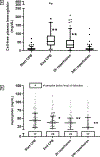Association Between Hyperoxemia and Increased Cell-Free Plasma Hemoglobin During Cardiopulmonary Bypass in Infants and Children
- PMID: 34560775
- PMCID: PMC8816845
- DOI: 10.1097/PCC.0000000000002814
Association Between Hyperoxemia and Increased Cell-Free Plasma Hemoglobin During Cardiopulmonary Bypass in Infants and Children
Abstract
Objectives: To determine potential risk factors for severe hemolysis during pediatric cardiopulmonary bypass and examine whether supraphysiologic levels of oxygen and cardiopulmonary bypass duration are associated with hemolysis.
Design: Prospective observational study.
Setting: Cardiac ICU in a university-affiliated children's hospital.
Patients: Greater than 1 month to less than 18 years old patients undergoing cardiopulmonary bypass for cardiac surgery.
Interventions: None.
Measurements and main results: Plasma samples from 100 patients to assess cell-free plasma hemoglobin levels were obtained at start cardiopulmonary bypass, at the end of cardiopulmonary bypass, and 2 and 24 hours after reperfusion. Arterial blood gas samples were obtained before and every 30 minutes during cardiopulmonary bypass. Patient demographics and laboratory data were collected from the electronic medical record. Plasma hemoglobin levels peaked at the end of cardiopulmonary bypass and haptoglobin levels continued to fall throughout all time points. There were 44 patients with severe hemolysis (change in cell-free plasma hemoglobin > 50 mg/dL). Younger age (odds ratio/sd 0.45 [95% CI, 0.25-0.81]) and higher mean Pao2 × cardiopulmonary bypass duration (31.11 [1.46-664.64]) were identified as risk factors for severe hemolysis in multivariable analysis. Severe hemolysis was associated with longer hospital and ICU lengths of stay as well as acute kidney injury.
Conclusions: We observed younger age and the exposure to both oxygen and duration of cardiopulmonary bypass as risk factors for hemolysis. Oxygen delivery through the cardiopulmonary bypass circuit is an easily modifiable risk factor. Its role in the production of reactive oxygen species that could alter the erythrocyte membrane deserves further examination in larger prospective studies.
Copyright © 2021 by the Society of Critical Care Medicine and the World Federation of Pediatric Intensive and Critical Care Societies.
Conflict of interest statement
Dr. Bayir received funding from Nestle; she was supported by the University of Pittsburgh Medical Center Scientific Program. Drs. Bayir and Kim-Campell received support for article research from the National Institutes of Health (NIH). Dr. Kochanek received funding from Society of Critical Care Medicine and World Federation of Pediatric Intensive & Critical Care Societies for serving as the Editor-in-Chief of Pediatric Critical Care Medicine. Dr. Kim-Campbell was supported by the Ann E. Thompson Fellow Scholarship Award; she received funding from University of Pittsburgh Clinical and Translational Science Institute (UL1 TR000005), the Vascular Medicine Institute, the Hemophilia Center of Western Pennsylvania, the Institute for Transfusion Medicine, and the NIH (T32HD040686, K12HL109068, K23HD100553). The remaining authors have disclosed that they do not have any potential conflicts of interest.
Figures


Comment in
-
The March of the Normoxics: Hyperoxemia and Hemolysis During Cardiopulmonary Bypass.Pediatr Crit Care Med. 2022 Feb 1;23(2):146-148. doi: 10.1097/PCC.0000000000002891. Pediatr Crit Care Med. 2022. PMID: 35119436 No abstract available.
References
-
- Vermeulen Windsant IC, Hanssen SJ, Buurman WA, et al.: Cardiovascular surgery and organ damage: time to reconsider the role of hemolysis. J Thorac Cardiovasc Surg 2011;142:1–11 - PubMed
-
- Dalton HJ, Cashen K, Reeder RW, et al.: Hemolysis During Pediatric Extracorporeal Membrane Oxygenation: Associations With Circuitry, Complications, and Mortality. Pediatric critical care medicine : a journal of the Society of Critical Care Medicine and the World Federation of Pediatric Intensive and Critical Care Societies 2018;19:1067–1076 - PMC - PubMed
-
- Reiter CD, Wang X, Tanus-Santos JE, et al.: Cell-free hemoglobin limits nitric oxide bioavailability in sickle-cell disease. Nature medicine 2002;8:1383–1389 - PubMed
Publication types
MeSH terms
Substances
Grants and funding
LinkOut - more resources
Full Text Sources

